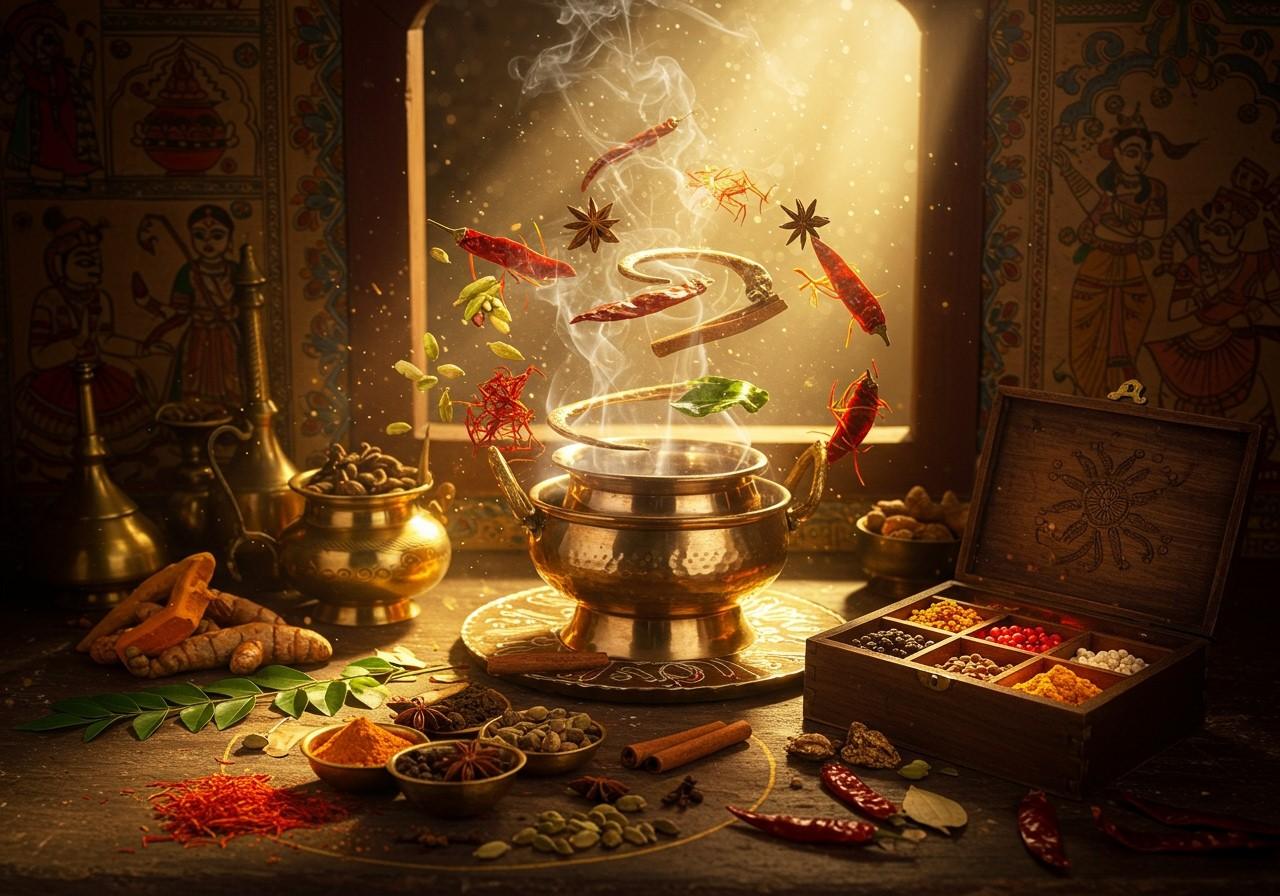
Indian curry is more than just a spicy dish; it’s a culinary voyage brimming with rich flavors and cultural significance. Across India, each region boasts its unique interpretation of curry, shaped by local ingredients and time-honored traditions. From the creamy curries of North India to the fiery dishes of the South, let’s embark on an exploration of the diverse world of Indian curry.
What is Curry in Hindi?
In Hindi, curry is often referred to as ‘सब्ज़ी’ (sabzi) or ‘करी’ (kari). North Indian curries are renowned for their use of aromatic spices like garam masala, cumin, and coriander. Among the popular dishes are Paneer Butter Masala, Chana Masala, and Rajma. These curries hold a significant place in traditional meals, often gracing festivals and celebrations. Common cooking techniques in Hindi-speaking regions include slow simmering and tempering spices.
What is Curry Meaning in Telugu?
In Telugu, curry is known as ‘కూర’ (kura) or ‘కూడి’ (kodi). Telugu curries often incorporate ingredients such as tamarind, coconut, and red chilies. Notable dishes include Gongura Mutton, Andhra Chicken Curry, and Pappu Charu. Curry plays a vital role in the culinary traditions of Andhra Pradesh and Telangana, especially during festivals like Sankranti and Ugadi. Traditional cooking methods frequently involve the use of clay pots and time-honored utensils.
What is Curry in Tamil?
Tamil curries are called ‘கறி’ (kari) or ‘குழம்பு’ (kuzhambu). They are characterized by unique ingredients such as curry leaves, mustard seeds, and tamarind. Popular Tamil curries include Chettinad Chicken, Sambar, and Rasam. Traditional cooking methods often utilize clay pots and banana leaves. Curry holds a significant place in Tamil culture, particularly during religious ceremonies and family gatherings.
The Evolution of Indian Curry
Indian curry has evolved over centuries, drawing influences from Mughal, Persian, and British cuisines. The introduction of chili peppers by the Portuguese marked a significant turning point. Regional variations and locally sourced ingredients have shaped the diverse array of Indian curries we relish today. Indian curry has made its mark globally, adapting to various international cuisines while preserving its cultural significance.
Regional Variations of Indian Curry
Indian curry exhibits remarkable diversity across regions:
- North India: Known for rich, creamy curries such as Butter Chicken and Korma, often featuring yogurt and nuts.
- South India: Characterized by fiery and tangy curries like Andhra Pepper Chicken and Kerala Fish Curry, using coconut milk and tamarind.
- Coastal regions: Coconut-based curries like Goan Prawn Curry and Malabar Chicken Curry are prevalent, incorporating fresh seafood and coconut milk.
- Western India: Vegetarian delights like Gujarati Undhiyu and Rajasthani Gatte ki Sabzi are common, highlighting local vegetables and spices.
- Eastern India: Offers unique flavors with dishes like Bengali Fish Curry and Assamese Duck Curry, often using mustard oil and freshwater fish.
Cooking Techniques and Ingredients
Essential Ingredients
Indian curry relies heavily on spices such as turmeric, cumin, coriander, and cardamom. Aromatics like onions, garlic, and ginger form the base of many curries. Dairy products like yogurt and cream contribute richness to North Indian dishes.
Key Techniques
Slow simmering allows for the development of deep flavors. Tempering spices in hot oil releases their aroma and enhances the curry’s taste. Striking a balance between sweet, sour, and spicy flavors is essential for crafting the perfect curry.
Enhancing Your Curry Experience with Poojn.in
Turmeric (Haldi) is a cornerstone of Indian curries, and Poojn.in offers pure, high-quality turmeric that upholds traditional standards. Sourced responsibly, our turmeric retains the authentic qualities essential for both cooking and ceremonies.
At Poojn.in, we offer:
- Premium Haldi powder ideal for authentic Indian curries, maintaining traditional flavor profiles.
- Pure turmeric suitable for both culinary and ceremonial purposes, ensuring purity and quality.
- Traditional packaging that preserves the spice’s natural properties, retaining freshness and aroma.
- Convenient online ordering with pan-India delivery, making it accessible to everyone.
Our turmeric is perfect for:
- Everyday cooking, adding vibrant color and flavor to your dishes.
- Wedding ceremonies (Haldi ritual), upholding traditional customs.
- Religious ceremonies, maintaining the sanctity of rituals.
- Ayurvedic remedies, harnessing the natural healing properties of turmeric.
Shop for pure Haldi powder at Poojn.in
Our turmeric adheres to the highest purity standards, making it ideal for traditional Indian curries while preserving its sacred significance in Hindu rituals. Each package includes storage instructions to maintain freshness and potency.
Note: Explore our full range of traditional spices and ceremonial items at Poojn.in for your culinary and religious needs.
Conclusion: Embracing the Diversity of Indian Curry
Indian curry is a cherished culinary gem reflecting India’s rich cultural tapestry. Each curry narrates a story of its region, traditions, and distinct flavors. From the creamy, aromatic curries of the North to the fiery, tangy dishes of the South, every bite is an adventure.
Exploring diverse recipes and cooking techniques allows us to appreciate the artistry behind these delectable dishes. Whether you’re savoring Rajma in Punjab or a spicy Andhra Chicken Curry, you partake in India’s vibrant culture.
As you delve into Indian curry, remember it’s more than just food; it’s a celebration of tradition and community. Relish the flavors, cherish the memories, and embrace the culinary journey that is Indian curry.
Curry: Beyond the Spice – An FAQ
What are some popular Indian curry recipes? Modern Indian cuisine offers a plethora of curry options. Vegetarian choices often incorporate lentils, beans, or paneer. Quick and easy chicken curry recipes utilize tomato, yogurt, coconut milk, and spices, ready in under an hour. For those seeking authentic flavors, chefs like Hari Ghotra offer traditional recipes for chicken, lamb, fish, and vegetarian curries.
Is all curry spicy? Not every curry is spicy. The level of heat can be adjusted to suit individual preferences, from mild to fiery.
Are there vegetarian curry options? Absolutely! Vegetarian curries are widely enjoyed and often feature vegetables, lentils, paneer (Indian cheese), or tofu.
What’s the typical cooking time for curry? Curry cooking times vary, with many dishes ready in 30 minutes to an hour. Some more complex curries benefit from longer simmering times.
What are the best accompaniments for curry? Curry is traditionally served hot with rice, naan bread, roti, or other Indian breads. Raita (yogurt dip) and various chutneys complement the flavors beautifully.
Prasad Recipes: A Guide to Significance and Taste
Festive Feasts: Sattvic Recipes for Delicious Celebrations


